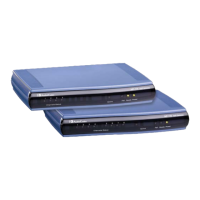Version 7.2 1051 Mediant 1000B Gateway & E-SBC
User's Manual 62. Configuration Parameters Reference
Parameter Description
Otherwise, for allowed Caller ID, 'Privacy: none' is used. If Caller
ID is restricted (received from Tel or configured in the device),
the From header is set to <anonymous@anonymous.invalid>.
For Digital Interfaces: The 200 OK response can contain the
connected party CallerID - Connected Number and Connected
Name. For example, if the call is answered by the device, the
200 OK response includes the P-Asserted-
The device interworks (in some ISDN variants), the Connected
Party number and name from Q.931 Connect message to SIP
200 OK with the P-Asserted-Identity header. In the opposite
direction, if the ISDN device receives a 200 OK with P-Asserted-
Identity header, it interworks it to the Connected party number
and name in the Q.931 Connect message, including its privacy.
Use Destination As Connected
Number
configure voip > sip-definition
settings > use-dst-as-connected-
num
[UseDestinationAsConnectedNum
ber]
Enables the device to include the Called Party Number, from
outgoing Tel calls (after number manipulation), in the SIP P-
Asserted-Identity header. The device includes the SIP P-
Asserted-Identity header in 180 Ringing and 200 OK responses
for IP-to-Tel calls.
[0] Disable (default)
[1] Enable
Note:
For this feature to function, you also need to enable the
device to include the P-Asserted-Identity header in 180/200
OK responses, by setting the AssertedIDMode parameter to
Add P-Asserted-Identity.
If the received Q.931 Connect message contains a
Connected Party Number, this number is used in the P-
Asserted-Identity header in 200 OK response.
The parameter is applicable to FXO, ISDN and CAS
interfaces.
Caller ID Transport Type
configure voip > media fax-
> caller-ID-transport-type
[CallerIDTransportType]
Determines the device's behavior for Caller ID detection.
[0] Disable = The caller ID signal is not detected - DTMF
digits remain in the voice stream.
[1] Relay = (Currently not applicable.)
[3] Mute = (Default) The caller ID signal is detected from the
Tel side and then erased from the voice stream.
Note: Caller ID detection is applicable only to FXO interfaces.
Reject Anonymous Calls Per Port Table
configure voip > gateway analog
reject-anonymous-calls
[RejectAnonymousCallPerPort]
This table parameter determines whether the device rejects
incoming anonymous calls per FXS port. If enabled, when a
device's FXS interface receives an anonymous call, it rejects the
call and responds with a SIP 433 (Anonymity Disallowed)
response.
The format of the ini file table parameter is as follows:
[RejectAnonymousCallPerPort]
FORMAT RejectAnonymousCallPerPort_Index =
RejectAnonymousCallPerPort_Enable,
RejectAnonymousCallPerPort_Port,
RejectAnonymousCallPerPort_Module;
[\RejectAnonymousCallPerPort]

